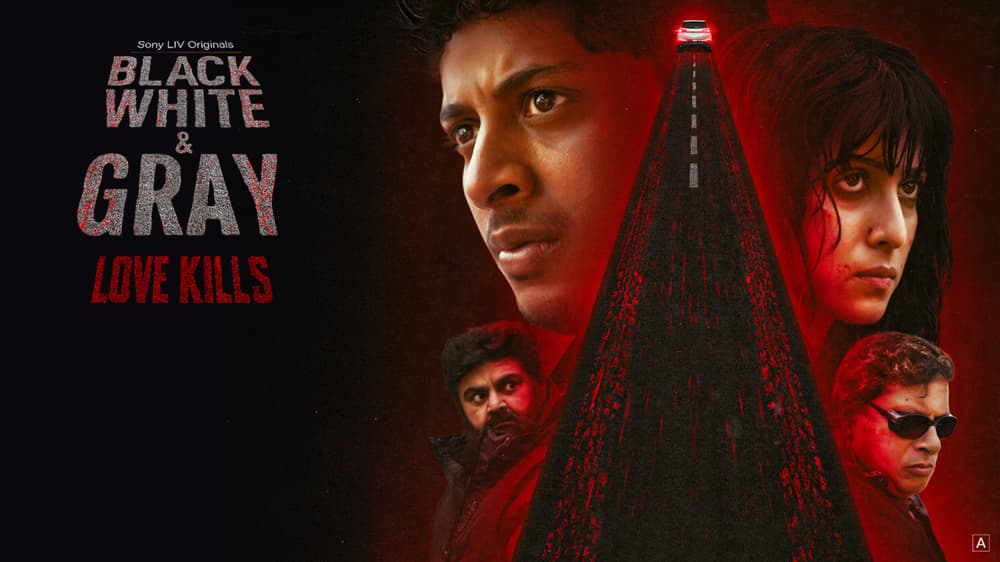Black, White & Gray – Love Kills is a gripping mockumentary-style crime thriller on SonyLIV that unravels the story of a young man accused of murdering four people, including his lover, as a journalist digs deep into the blurred lines between love, truth, and deception.

"Black, White & Gray – Love Kills" is a daring and thought-provoking installment in the new OTT release lineup on SonyLIV and carries the limited release of a six-episode Hindi crime thriller. At the center of the mockumentary is a chilling tale of a 22-year-old fugitive charged with the murder of four people, including the woman he professes to love.
When a British journalist investigates the complicated story, the audience finds itself drawn into a murky realm of love-as-a-weapon, ambiguous morality, and where truth is something less than evident. With strong performances—especially by Mayur More and Palak Jaiswal—and an utterly believable portrayal of media, politics, and obsession, the series leaves the audience questioning the line between reality and pure fiction.
Layers of Love and Lies: The Tangled Plot of Black, White & Gray – Love Kills
At the heart of Black, White & Gray – Love Kills is an evil mystery: a 22-year-old man vanishes after being accused of murdering four people—among them, the lady he loved, who was also the daughter of a prominent politician. Two years have passed since, and his case is revived when Daniel Gray, a journalist from Britain, decides to revisit the case in documentary style, hoping to separate fact from fiction.
As Daniel gathers evidence through witness interviews, family members, and investigators, viewers find themselves swept up in a fractured chronology of fixation, class struggle, media manipulation, and psychological violence.
Where the story starts off as a conventional love affair that goes wrong, it quickly swerves into an incisive examination of entrenched corruption and the manner in which perception can be more poisonous than reality. As each episode ends, the general shape of the tale shifts—forces viewers repeatedly to reassess: who's the victim, and who's the killer?
Truth in Monochrome: A Deep Dive Review of Black, White & Gray – Love Kills
In a world overrun with crime shows and real-crime reboots, Black, White & Gray – Love Kills takes a risk and shatters the template. Streaming on SonyLIV as part of the new wave of OTT launches, this six-episode Hindi mockumentary thriller is not only a whodunit—it's a why-dunit, and a far more crucial one, a should-you-even-care-who-dunit.
The Premise: When Love Becomes the Crime Scene
The tale revolves around a young man, on the cusp of being in his early twenties, who goes missing after he is accused of murdering four individuals—one of them, his girlfriend and the daughter of a politically influential man.
What is so engagingly unique about this story is the prism it's told in: a faux-documentary by British journalist Daniel Gray (depicted with ironic disinterest), who strips away the layers of rumour, leaked tape fragments, old interview transcripts, and sensationalized staging to uncover a two-year-old case the press sensationalized and then rapidly forgot.
Direction & Style: A Mirror to Modern Media
Director Pushkar Sunil Mahabal doesn't merely show a crime—he questions how we watch one. Using a mockumentary style, the series artfully imitates the bingeable format of real-crime docuseries, then subverts it with creepy uncertainty. Are we seeing a documentary or a staged performance? Are these testimonies actual or re-staged? That unease is intentional, and it's part of the genius. The series quietly critiqued our shared voyeurism and insatiable appetite for "truth," however corrupted.
The aesthetic tone remains resolutely grey—both literally and symbolically. Dull color schemes, bold lighting, and handheld camera work emphasize the thematic ambiguity of the proceedings. Truth in this instance isn't white and black; it's grainy, disjointed, and perpetually out of shot.
Performances: Truth Tellers or Great Pretenders?
Mayur More, the quiet but inscrutable accused, gives a performance that is both touching and chilling. You never quite know whether to trust him or be afraid of him—and that's just what the role requires.
Palak Jaiswal is impressive as the multidimensional love interest. In flashbacks and statements, we witness her switching between victim, lover, and political pawn.
Tigmanshu Dhulia adds gravitas and grit to his turn as a retired cop with dubious loyalties and unclear motives.
Deven Bhojani, usually the go-to for comic timing, surprises in a darker, more subdued role, demonstrating his dramatic chops.
The supporting cast textures the story—each character having a piece of the puzzle but perhaps lying about how it fits.
Themes: Power, Perception, and Patriarchy
Under its thriller sheath, Black, White & Gray is acerbic insight into the powers that govern Indian society—politician dynasties, the machinery of media, patriarchal mores, and the class divisions that steer justice. Always, the show asks if it even matters how the truth came to be structured by privilege, pain, or prejudice.
The title isn't merely witty—it's the entire purpose. Something is never simply true or not true. Anyone is never quite innocent or culpable. The readers become the jury, judge, and occasional enabler.
Weak Spots: Pace & Payoff
Although the style is new, the storytelling occasionally stays too long on interviews or recycles scenes we've already witnessed. A more stringent edit in the middle would have honed the effect. Some viewers might also resent the absence of definitive closure—but that's the show's thesis: some stories don't conclude; they simply recede from the headlines.
Conclusion
Black, White & Gray – Love Kills is not your typical crime series. It's a multi-faceted psychological and societal thriller that challenges you to interrogate not just what you're seeing but also why you think what you think.
This SonyLIV original takes no prisoners with performances that linger, an intelligent story structure, and a refusal to hold your hand—and it deserves attention.
So if you want a show that will entertain while putting you through the emotional grinder in all the good and overwhelming ways you expect, add this to your watchlist.